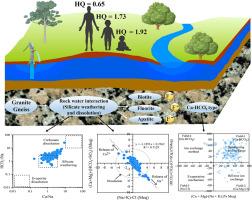印度中部花岗岩省地下水水化学动力学和氟化物污染的地质影响
Q2 Environmental Science
引用次数: 0
摘要
地下水中的氟化物(F -)在世界范围内构成严重的健康风险,特别是在半干旱地区。了解污染程度、水文地球化学过程和评估其潜在的人类健康风险对于制定有效的管理战略至关重要。本文采用岩石矿物学分析、水化学和多元统计技术,研究了印度北方邦Sonbhadra地区氟污染的空间分布和地球化学机制。此外,我们还探讨了人类活动(包括土地利用变化)对该地区地下水质量的影响。对199个地点的地下水样品进行了主要和次要离子分析,并对岩石进行了岩石学和矿物学分析,以确定含氟矿物相。地下水氟含量在0.1至9毫克/升之间变化,平均为1.39毫克/升,46%的样本超过了世卫组织的指导值(1.5毫克/升)。水化学数据表明,地下水质量主要受水岩相互作用、硅酸盐风化和离子交换过程的影响,而人为活动的影响相对较小。F−水平与Na+和HCO3−浓度呈正相关,证实了F−释放是由于硅酸盐矿物风化作用。岩石学和矿物学分析表明,地下水中的氟主要来源于花岗岩类岩石中的含氟矿物,如萤石、黑云母、磷灰石以及角闪洞、绿帘石和榍石的风化溶解作用。21.60%的成人、57.28%的儿童和62.81%的婴儿样本的危害商(hq氟化物)值超过1,突出表明儿童和婴儿的非致癌性健康影响风险高于成人。本文章由计算机程序翻译,如有差异,请以英文原文为准。

Geological influence on hydrochemical dynamics and fluoride contamination of groundwater from granitoid province in Central India
Fluoride (F−) in groundwater poses serious health risks worldwide, particularly in semi-arid regions. Understanding contamination levels, hydrogeochemical processes, and evaluating their potential human health risks are crucial for developing effective management strategies. In this study, we investigated the spatial distribution and geochemical mechanisms of F− contamination in Sonbhadra district, Uttar Pradesh (Central India), using petrographic-mineralogical analysis, hydrochemistry, and multivariate statistical techniques. Additionally, we explored the impact of human activities, including land-use changes, on groundwater quality in the region. Groundwater samples from 199 sites were analyzed for major and minor ions, while petrological and mineralogical analyses of rocks were conducted to identify F− bearing mineral phases. Groundwater F− levels varied from 0.1 to 9 mg/L, averaging 1.39 mg/L, with 46% of samples exceeded the WHO guideline value (1.5 mg/L). Hydrochemical data indicated that groundwater quality was primarily influenced by water-rock interactions, silicate weathering, and ion exchange processes, while the impact of anthropogenic activities was relatively minor. The F− levels exhibited a positive relationship with Na+ and HCO3− concentrations, confirming F− release due to silicate mineral weathering. Petrographic and mineralogical analyses indicated that the F− in groundwater primarily originates from weathering-dissolution of flouride containing minerals like fluorite, biotite and apatite as well as amphibole, epidote, and sphene present in the granitoid rocks. The hazard quotient (HQFluoride) values exceeded unity in 21.60% of samples for adults, 57.28% for children, and 62.81% for infants, highlighting that children and infants are at a higher risk of non-carcinogenic health effects compared to adults.
求助全文
通过发布文献求助,成功后即可免费获取论文全文。
去求助
来源期刊

Environmental Advances
Environmental Science-Environmental Science (miscellaneous)
CiteScore
7.30
自引率
0.00%
发文量
165
审稿时长
12 weeks
期刊介绍:
 求助内容:
求助内容: 应助结果提醒方式:
应助结果提醒方式:


